Sweet-and-sour pork.jpg on:
[Wikipedia]
[Google]
[Amazon]
Sweet and sour is a generic term that encompasses many styles of sauce, cuisine and cooking methods. It is commonly used in East Asia and Southeast Asia, and has been used in England since the Middle Ages. Dickson Wright, Clarissa (2011) ''A History of English Food''. Random House. . Pages 52–53 Sweet and sour sauce remains popular in Asian and Western cuisines.
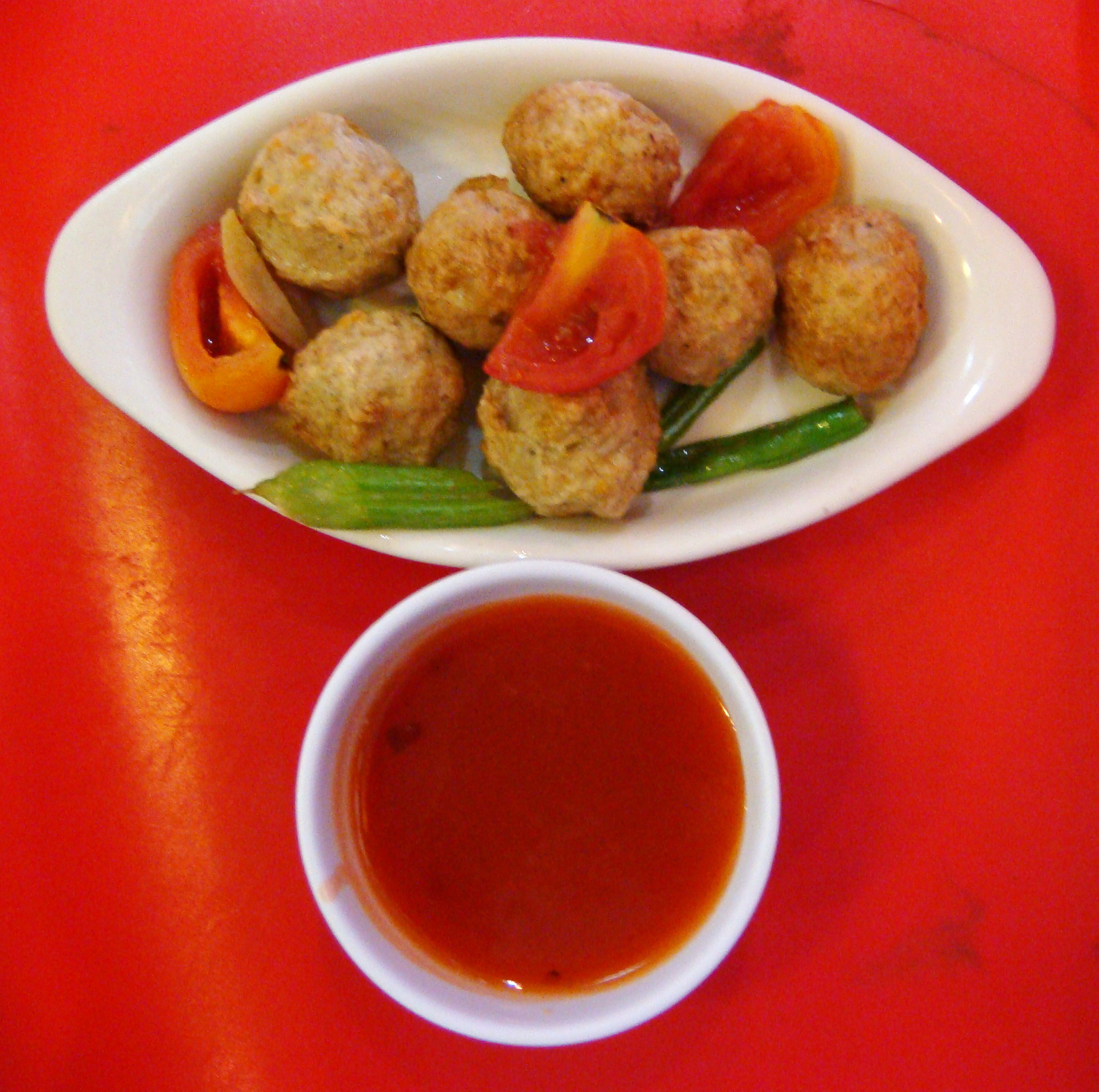 Sweet and sour dishes, sauces, and cooking methods have a long history in China. One of the earliest recordings of sweet and sour comes from《燒尾宴食單》, a menu of the food served in Tang Dynasty (618-907) festivals written in 708. It included many sweet and sour dishes and recorded that they were invented by Chancellor Wei Juyuan under Emperor Zhongzong of Tang when he hosted the Emperor at his house; one of them is the iconic Chinese dish sweet and sour spare ribs. Some authors say that the original sweet and sour sauce () came from the
Sweet and sour dishes, sauces, and cooking methods have a long history in China. One of the earliest recordings of sweet and sour comes from《燒尾宴食單》, a menu of the food served in Tang Dynasty (618-907) festivals written in 708. It included many sweet and sour dishes and recorded that they were invented by Chancellor Wei Juyuan under Emperor Zhongzong of Tang when he hosted the Emperor at his house; one of them is the iconic Chinese dish sweet and sour spare ribs. Some authors say that the original sweet and sour sauce () came from the 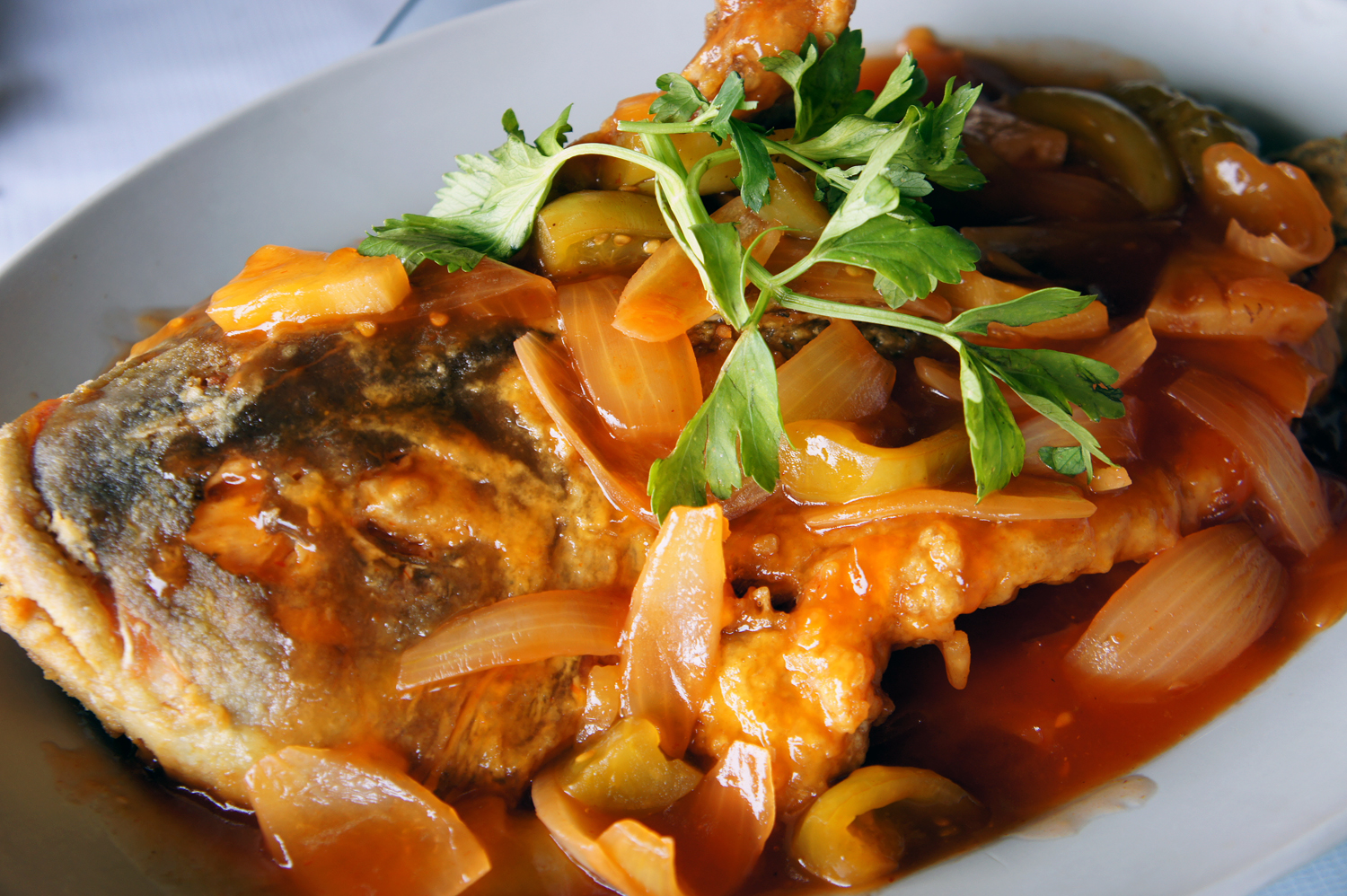 Cantonese sweet and sour sauce is the direct ancestor of the sauce of the same name in the West, and was originally developed for sweet and sour pork. The late renowned chef from Hong Kong Leung King included the following as his sweet and sour source sauce recipe: white rice vinegar, salt, Chinese brown candy, ketchup, Worcestershire sauce, and dark soy sauce. Hong Kong's gourmet Willie Mark Yiu-Tong (better known as Wei Ling, 唯靈), himself a long-time friend of Leung, suggests to contemporary eateries not to resort to cheap bulk manufactured versions of vinegar, ketchup, and Worcestershire sauce, or the sauce will risk being too sharp in taste and might break the balance of flavours. He suggests the more acidic white rice vinegar could be replaced with apple cider vinegar, and ketchup and Worcestershire sauce should be of renowned gourmet brands.
Cantonese sweet and sour sauce is the direct ancestor of the sauce of the same name in the West, and was originally developed for sweet and sour pork. The late renowned chef from Hong Kong Leung King included the following as his sweet and sour source sauce recipe: white rice vinegar, salt, Chinese brown candy, ketchup, Worcestershire sauce, and dark soy sauce. Hong Kong's gourmet Willie Mark Yiu-Tong (better known as Wei Ling, 唯靈), himself a long-time friend of Leung, suggests to contemporary eateries not to resort to cheap bulk manufactured versions of vinegar, ketchup, and Worcestershire sauce, or the sauce will risk being too sharp in taste and might break the balance of flavours. He suggests the more acidic white rice vinegar could be replaced with apple cider vinegar, and ketchup and Worcestershire sauce should be of renowned gourmet brands.
 ''Guo bao rou'' () is a classic dish from Northeast China (Dongbei), originating in
''Guo bao rou'' () is a classic dish from Northeast China (Dongbei), originating in
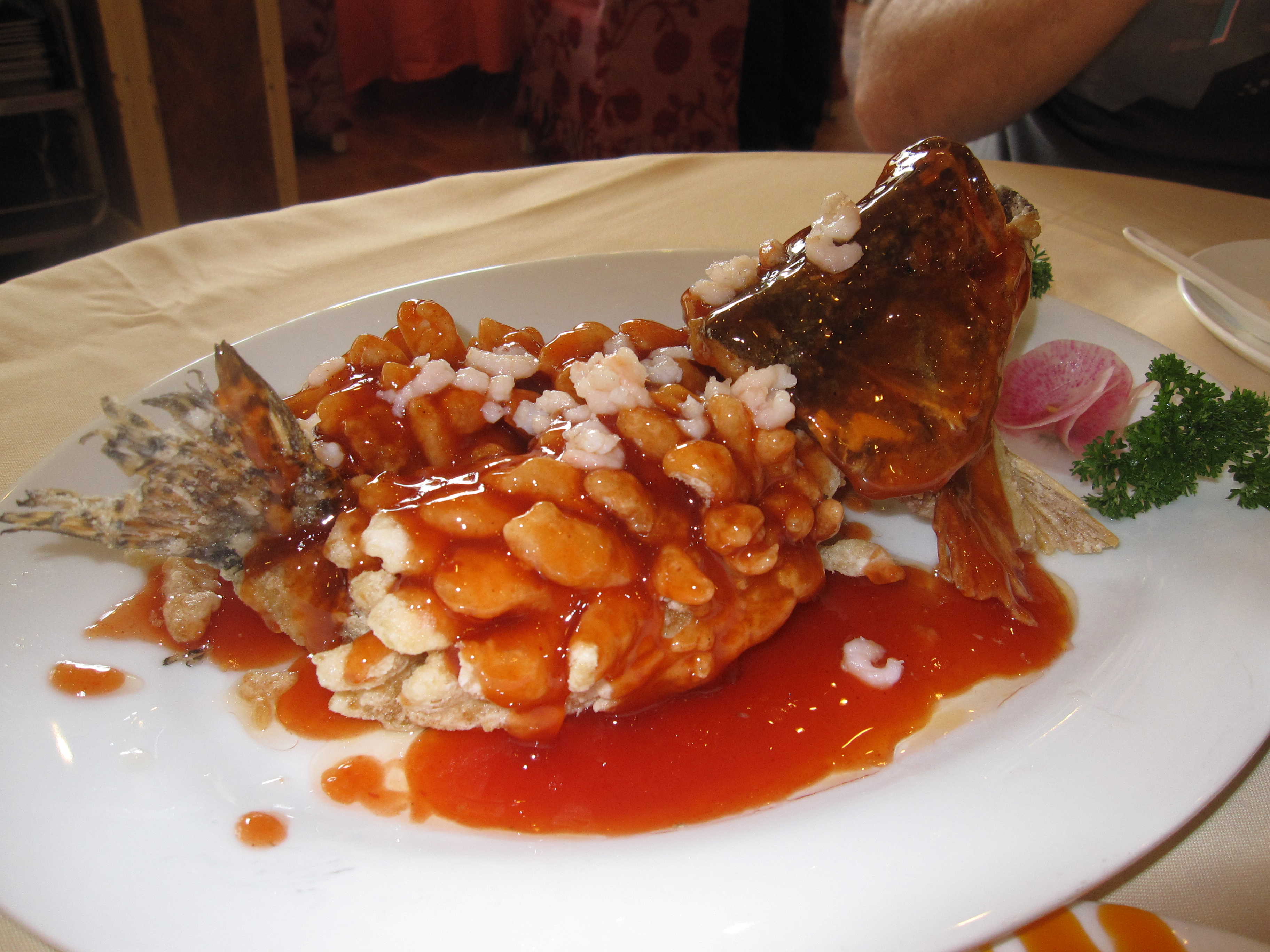 Originating in
Originating in
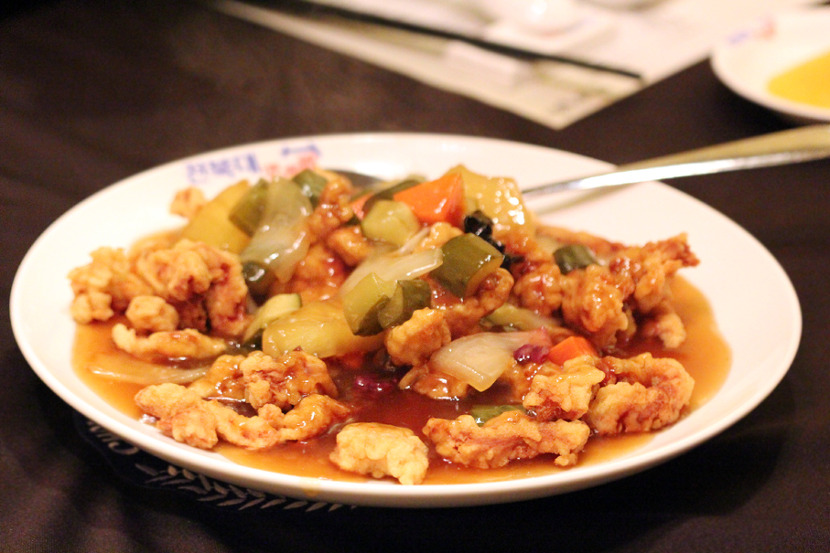 In South Korea, a sweet and sour meat dish known as ''
In South Korea, a sweet and sour meat dish known as ''
 Agrodolce is a traditional sweet and sour sauce in Italian cuisine. Its name comes from "agro" (sour) and "dolce" (sweet). Agrodolce is made by reducing sour and sweet elements, traditionally vinegar and
Agrodolce is a traditional sweet and sour sauce in Italian cuisine. Its name comes from "agro" (sour) and "dolce" (sweet). Agrodolce is made by reducing sour and sweet elements, traditionally vinegar and
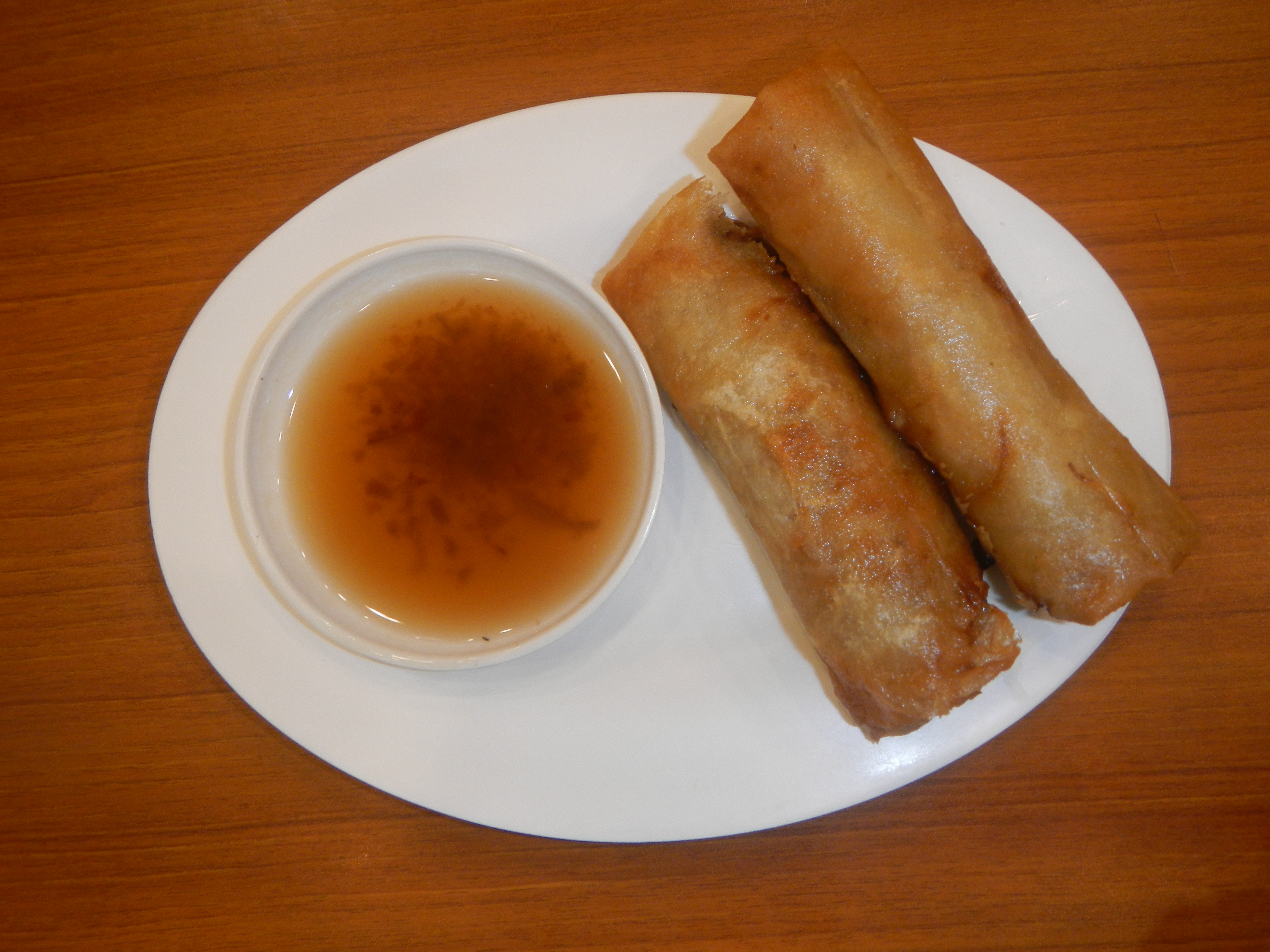 In Filipino cuisine, sweet and sour sauces are known as agre dulce or Filipino sweet and sour sauce. It is made by mixing cornstarch with water, salt, sugar, and a tangy ingredient; typically tomato ketchup, banana ketchup, or pineapples. The mixture is brought to a boil then simmered until it thickens. Labuyo chilis may also be added. The name means "sour-sweet" in Philippine Spanish, from Spanish ''agrio'' ("sour") and ''dulce'' ("sweet"). It is also known as ''agri dulci'' in Chavacano and can refer to dishes cooked with the sauce. ''Agre dulce'' is commonly used as a dipping sauce for appetizers like '' lumpia'' or '' okoy''.
In Filipino cuisine, sweet and sour sauces are known as agre dulce or Filipino sweet and sour sauce. It is made by mixing cornstarch with water, salt, sugar, and a tangy ingredient; typically tomato ketchup, banana ketchup, or pineapples. The mixture is brought to a boil then simmered until it thickens. Labuyo chilis may also be added. The name means "sour-sweet" in Philippine Spanish, from Spanish ''agrio'' ("sour") and ''dulce'' ("sweet"). It is also known as ''agri dulci'' in Chavacano and can refer to dishes cooked with the sauce. ''Agre dulce'' is commonly used as a dipping sauce for appetizers like '' lumpia'' or '' okoy''.

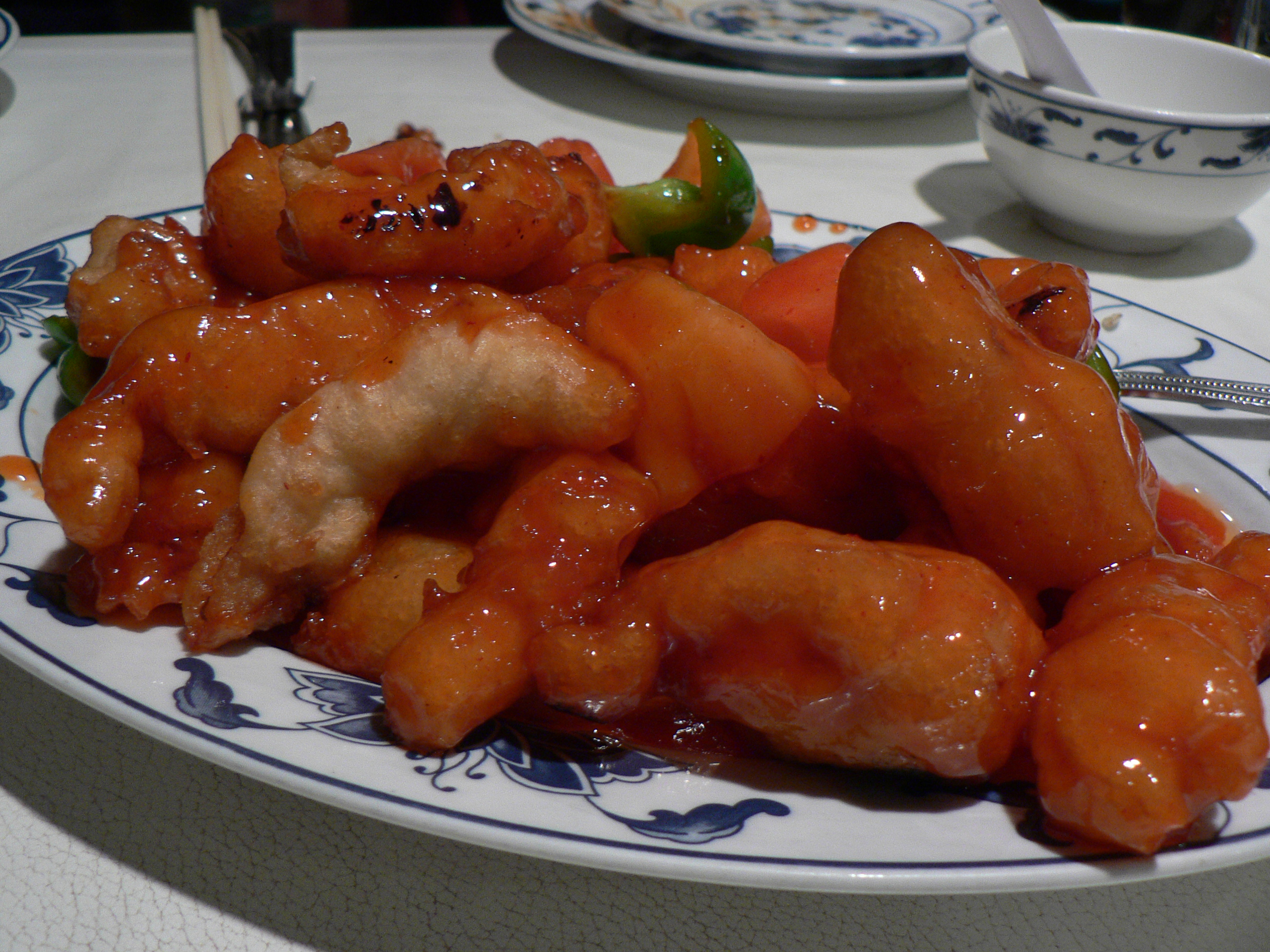 Sweet and sour chicken is a dish frequently served in Chinese restaurants in various countries in Oceania, Europe, North America and South America, and is available at some restaurants in East Asia and Southeast Asia in an essentially identical version. The dish generally comprises cubes of white meat chicken deep-fried in batter and served with sweet and sour sauce. Sometimes it is topped with pineapple, green pepper, carrot, or sweet pickles.
Sweet and sour pork is a Chinese dish particularly popular in westernised Cantonese cuisine and may be found all over the world. Several provinces in China produce various dishes that claim to be the ancestor including a traditional Jiangsu dish called Pork in a sugar and vinegar sauce (糖醋里脊; pinyin: táng cù lǐjǐ).
The dish consists of deep fried pork in bite sized pieces, and subsequently stir-fried in a more customized version of sweet and sour sauce made of sugar, ketchup, white vinegar, and soy sauce, and additional ingredients including pineapple, green pepper ( capsicum), and onion. In more elaborate preparations, the dish's tartness is controlled by requiring that Chinese white rice vinegar be used sparingly and using ketchups with less vinegary tastes, while some restaurants use unripe kiwifruits and HP sauce in place of vinegar. pg 27, Issue 758, Eat and Travel Weekly, Eat and Travel Weekly Company Ltd, Hong Kong, 2 August 2006
Western cultures use sweet and sour sauce in two different ways. Dishes can either include the sauce as an ingredient in cooking or use the sauce as a pour-over or dipping sauce for the meal.
Chinese restaurants in Western countries commonly serve chicken, pork, or shrimp that has been battered and deep-fried, then served with a sweet and sour sauce poured over the meat. It is also common to find the sweet and sour sauce cooked with sliced green peppers, onions and pineapple before it is poured over the meat.
Many western dishes involve cooking the meat with a variety of ingredients to make a complete sweet and sour dish in the manner of the Gu lo yuk. The most popular dishes are those of pork and shrimp. In French cuisine, it has been developed contrary to traditional French cooking practices and preparation of sweet and sour sauce (Aigre-douce) often involves immersing the food in a plentiful amount of sauce.
Common in Western sweet and sour sauce is the addition of fruits such as pineapple and vegetables such as sweet pepper and green onions. Traditional rice vinegar is becoming more readily available due to the increase in Asian food stores but a mixture of vinegar and dry sherry is often still used in sweet and sour dishes. Also common is the use of corn starch as thickener for the sauce and tomato ketchup to give a stronger red colour to the dish and to add a Western taste. Most supermarkets across Europe and North America carry a range of prepared sweet and sour sauces either for adding to a stir-fry or for use as a dipping sauce.
Primarily in
Sweet and sour chicken is a dish frequently served in Chinese restaurants in various countries in Oceania, Europe, North America and South America, and is available at some restaurants in East Asia and Southeast Asia in an essentially identical version. The dish generally comprises cubes of white meat chicken deep-fried in batter and served with sweet and sour sauce. Sometimes it is topped with pineapple, green pepper, carrot, or sweet pickles.
Sweet and sour pork is a Chinese dish particularly popular in westernised Cantonese cuisine and may be found all over the world. Several provinces in China produce various dishes that claim to be the ancestor including a traditional Jiangsu dish called Pork in a sugar and vinegar sauce (糖醋里脊; pinyin: táng cù lǐjǐ).
The dish consists of deep fried pork in bite sized pieces, and subsequently stir-fried in a more customized version of sweet and sour sauce made of sugar, ketchup, white vinegar, and soy sauce, and additional ingredients including pineapple, green pepper ( capsicum), and onion. In more elaborate preparations, the dish's tartness is controlled by requiring that Chinese white rice vinegar be used sparingly and using ketchups with less vinegary tastes, while some restaurants use unripe kiwifruits and HP sauce in place of vinegar. pg 27, Issue 758, Eat and Travel Weekly, Eat and Travel Weekly Company Ltd, Hong Kong, 2 August 2006
Western cultures use sweet and sour sauce in two different ways. Dishes can either include the sauce as an ingredient in cooking or use the sauce as a pour-over or dipping sauce for the meal.
Chinese restaurants in Western countries commonly serve chicken, pork, or shrimp that has been battered and deep-fried, then served with a sweet and sour sauce poured over the meat. It is also common to find the sweet and sour sauce cooked with sliced green peppers, onions and pineapple before it is poured over the meat.
Many western dishes involve cooking the meat with a variety of ingredients to make a complete sweet and sour dish in the manner of the Gu lo yuk. The most popular dishes are those of pork and shrimp. In French cuisine, it has been developed contrary to traditional French cooking practices and preparation of sweet and sour sauce (Aigre-douce) often involves immersing the food in a plentiful amount of sauce.
Common in Western sweet and sour sauce is the addition of fruits such as pineapple and vegetables such as sweet pepper and green onions. Traditional rice vinegar is becoming more readily available due to the increase in Asian food stores but a mixture of vinegar and dry sherry is often still used in sweet and sour dishes. Also common is the use of corn starch as thickener for the sauce and tomato ketchup to give a stronger red colour to the dish and to add a Western taste. Most supermarkets across Europe and North America carry a range of prepared sweet and sour sauces either for adding to a stir-fry or for use as a dipping sauce.
Primarily in
General sauce recipes
Sweet and Sour Recipe
{{DEFAULTSORT:Sweet And Sour American Chinese cuisine British cuisine Chinese cuisine Chinese sauces
By region
East Asia
Chinese cuisine
Chinese province
The provincial level administrative divisions () are the highest-level administrative divisions of China. There are 34 such divisions claimed by the People's Republic of China, classified as 23 provinces (), five autonomous regions, four muni ...
of Henan, but the sauce in this area is a light vinegar and sugar mixture not resembling what most people, including the Chinese, would call sweet and sour. Many places in China
China, officially the People's Republic of China (PRC), is a country in East Asia. It is the world's most populous country, with a population exceeding 1.4 billion, slightly ahead of India. China spans the equivalent of five time zones and ...
use a sweet and sour sauce as a dipping sauce for fish and meat, rather than in cooking as is commonly found in westernized Chinese cuisine.
This style of using sauces is popular amongst Chinese who tie certain sauces to particular meats such as chili and soy for shrimp and vinegar and garlic
Garlic (''Allium sativum'') is a species of bulbous flowering plant in the genus ''Allium''. Its close relatives include the onion, shallot, leek, chive, Allium fistulosum, Welsh onion and Allium chinense, Chinese onion. It is native to South A ...
for goose. There are, however, some dishes, such as the Cantonese sweet and sour pork or loong har kow (sweet and sour lobster balls), in which the meat is cooked and a sauce added to the wok before serving.
Not all dishes are cooked; some, such as "sweet and sour fruit and vegetable" salad from the eastern regions of China, also find their way in Chinese cuisine. This dish combines salad vegetables such as cucumber
Cucumber (''Cucumis sativus'') is a widely-cultivated Vine#Horticultural climbing plants, creeping vine plant in the Cucurbitaceae family that bears usually cylindrical Fruit, fruits, which are used as culinary vegetables.
, tomato, bell pepper
The bell pepper (also known as paprika, sweet pepper, pepper, or capsicum ) is the fruit of plants in the Grossum Group of the species ''Capsicum annuum''. Cultivars of the plant produce fruits in different colors, including red, yellow, orange ...
, and onion with a mixture of pineapple (or pear), vinegar, and sugar to make a cold served dish.
In China traditionally the sauces are made from mixing sugar or honey with a sour liquid such as rice vinegar, soy sauce
Soy sauce (also called simply soy in American English and soya sauce in British English) is a liquid condiment of Chinese origin, traditionally made from a fermented paste of soybeans, roasted grain, brine, and '' Aspergillus oryzae'' or ''Asp ...
, and spices such as ginger
Ginger (''Zingiber officinale'') is a flowering plant whose rhizome, ginger root or ginger, is widely used as a spice
A spice is a seed, fruit, root, bark, or other plant substance primarily used for flavoring or coloring food. Spices ...
and cloves. Sometimes a paste made from tomatoes is used but this is rare and normally restricted to Western cooking.
 Cantonese sweet and sour sauce is the direct ancestor of the sauce of the same name in the West, and was originally developed for sweet and sour pork. The late renowned chef from Hong Kong Leung King included the following as his sweet and sour source sauce recipe: white rice vinegar, salt, Chinese brown candy, ketchup, Worcestershire sauce, and dark soy sauce. Hong Kong's gourmet Willie Mark Yiu-Tong (better known as Wei Ling, 唯靈), himself a long-time friend of Leung, suggests to contemporary eateries not to resort to cheap bulk manufactured versions of vinegar, ketchup, and Worcestershire sauce, or the sauce will risk being too sharp in taste and might break the balance of flavours. He suggests the more acidic white rice vinegar could be replaced with apple cider vinegar, and ketchup and Worcestershire sauce should be of renowned gourmet brands.
Cantonese sweet and sour sauce is the direct ancestor of the sauce of the same name in the West, and was originally developed for sweet and sour pork. The late renowned chef from Hong Kong Leung King included the following as his sweet and sour source sauce recipe: white rice vinegar, salt, Chinese brown candy, ketchup, Worcestershire sauce, and dark soy sauce. Hong Kong's gourmet Willie Mark Yiu-Tong (better known as Wei Ling, 唯靈), himself a long-time friend of Leung, suggests to contemporary eateries not to resort to cheap bulk manufactured versions of vinegar, ketchup, and Worcestershire sauce, or the sauce will risk being too sharp in taste and might break the balance of flavours. He suggests the more acidic white rice vinegar could be replaced with apple cider vinegar, and ketchup and Worcestershire sauce should be of renowned gourmet brands.
=Hong Kong/Cantonese
= The original Cantonese sweet and sour pork () is made with vinegar, preserved plums and hawthorn candy for an almost scarlet colour and sweet-sour taste. A related Hong Kong/ Cantonese-based dish is sweet and sour spare-ribs () and it is identical in methods except spare-ribs are used in place of pork loins.=Guo bao rou
= ''Guo bao rou'' () is a classic dish from Northeast China (Dongbei), originating in
''Guo bao rou'' () is a classic dish from Northeast China (Dongbei), originating in Harbin
Harbin (; mnc, , v=Halbin; ) is a sub-provincial city and the provincial capital and the largest city of Heilongjiang province, People's Republic of China, as well as the second largest city by urban population after Shenyang and largest ...
, Heilongjiang Province. It consists of large thinly sliced pieces of pork tenderloin in potato starch batter
Batter or batters may refer to:
Common meanings
* Batter (cooking), thin dough that can be easily poured into a pan
* Batter (baseball), person whose turn it is to face the pitcher
* Batter (cricket), a player who is currently batting
* Batter ...
, deep-fried twice until crispy. They are then lightly coated in a variation of a sweet and sour sauce, made from freshly prepared syrup and rice vinegar, flavoured with ginger and garlic. The batter absorbs the sauce and softens. A Beijing variant has the sauce thin and watery, while the dish as prepared in Liaoning Province is often a thicker sauce with ketchup (tomato sauce) added to it. However, the true or original version of guō bāo ròu served in Harbin, Heilongjiang Province, is made with an amber-coloured sauce due to the fact that it uses caramelized sugar.
=Squirrel-shaped Mandarin fish
= Originating in
Originating in Suzhou
Suzhou (; ; Suzhounese: ''sou¹ tseu¹'' , Mandarin: ), alternately romanized as Soochow, is a major city in southern Jiangsu province, East China. Suzhou is the largest city in Jiangsu, and a major economic center and focal point of trade ...
, Jiangsu province, the ''squirrel-shaped Mandarin fish'' () has a crisp skin but soft centre. The fish body of '' Siniperca chuatsi'' is scored such that it fans out when cooked, similar in appearance to a bushy squirrel tail. The fish is served with a sweet and sour sauce drizzled on top and garnished with a little shrimp meat and dried bamboo shoots.
=Sweet and sour Yellow River carp
= A speciality ofShandong
Shandong ( , ; ; alternately romanized as Shantung) is a coastal province of the People's Republic of China and is part of the East China region.
Shandong has played a major role in Chinese history since the beginning of Chinese civilizati ...
province, in particular the city of Jinan
Jinan (), Postal Map Romanization, alternately romanization of Chinese, romanized as Tsinan, is the Capital (political), capital of Shandong province in East China, Eastern China. With a population of 9.2 million, it is the second-largest city i ...
, the ''Yellow River carp'' is prepared by making diagonal slices partway through its flesh. It is next coated in corn flour then deep fried causing the fish to curl and the slices to open out. Finally a sweet and sour sauce is poured over the cooked fish. This is one of the distinctive dishes typical of Lu Cuisine.
=Sweet and sour spare ribs
= A popular dish in Shanghai cuisine, sweet and sour spare ribs () are made using pork ribs that are lightly coated in corn starch and seasoned before being fried and served in a sweet and sour sauce.Korean cuisine
 In South Korea, a sweet and sour meat dish known as ''
In South Korea, a sweet and sour meat dish known as ''tangsuyuk
''Tangsuyuk'' () is a Korean Chinese meat dish with sweet and sour sauce. It can be made with either pork or beef.
History and etymology
''Tangsuyuk'' is a dish that was first made by Chinese merchants in the port city of Incheon, where the ...
'' () is one of the most popular Korean Chinese dishes. Made with either pork or beef, the bite-sized pieces are usually coated with potato/sweet potato starch/corn starch
Corn starch, maize starch, or cornflour (British English) is the starch derived from corn (maize) grain. The starch is obtained from the endosperm of the kernel. Corn starch is a common food ingredient, often used to thicken sauces or sou ...
or glutinous rice flour
Domestication syndrome refers to two sets of phenotypic traits that are common to either domesticated animals, or domesticated plants. These traits were identified by Charles Darwin in '' The Variation of Animals and Plants Under Domestication. ...
, and double-fried in oil. The dish is served with sweet and sour sauce, typically made by boiling vinegar, sugar
Sugar is the generic name for sweet-tasting, soluble carbohydrates, many of which are used in food. Simple sugars, also called monosaccharides, include glucose, fructose, and galactose. Compound sugars, also called disaccharides or double ...
, and water, with variety of fruits and vegetables like carrot
The carrot ('' Daucus carota'' subsp. ''sativus'') is a root vegetable, typically orange in color, though purple, black, red, white, and yellow cultivars exist, all of which are domesticated forms of the wild carrot, ''Daucus carota'', nat ...
, cucumber
Cucumber (''Cucumis sativus'') is a widely-cultivated Vine#Horticultural climbing plants, creeping vine plant in the Cucurbitaceae family that bears usually cylindrical Fruit, fruits, which are used as culinary vegetables.
, onion, wood ear mushroom, and pineapple. Starch slurry is used to thicken the sauce.
Europe
English cuisine
Sweet and sour sauces have been used in English cuisine since the Middle Ages, with recipes for sweet and sour meat and fish in the 1390 cookery book '' The Forme of Cury''.French cuisine
In French cuisine, a sweet and sour sauce base made from sugar and vinegar is agastrique
Gastrique is caramelized sugar, deglazed with vinegar or other sour liquids, used as a sweet and sour flavoring for sauces.
The gastrique is generally added to a fond, reduced stock or brown sauce. It is also used to flavor sauces such as toma ...
. "Aigre-doux" is a sweet and sour sauce in general.
Italian cuisine
 Agrodolce is a traditional sweet and sour sauce in Italian cuisine. Its name comes from "agro" (sour) and "dolce" (sweet). Agrodolce is made by reducing sour and sweet elements, traditionally vinegar and
Agrodolce is a traditional sweet and sour sauce in Italian cuisine. Its name comes from "agro" (sour) and "dolce" (sweet). Agrodolce is made by reducing sour and sweet elements, traditionally vinegar and sugar
Sugar is the generic name for sweet-tasting, soluble carbohydrates, many of which are used in food. Simple sugars, also called monosaccharides, include glucose, fructose, and galactose. Compound sugars, also called disaccharides or double ...
. Sometimes, additional flavorings are added, such as wine, fruit, or even chocolate. One recipe for lamb agrodolce is served over rigatoni
Rigatoni () are a form of tube-shaped pasta of varying lengths and diameters originating in Italy. They are larger than penne and ziti, and sometimes slightly curved. If so, they are not as curved as elbow macaroni. Rigatoni characteristically ...
or wide noodles, such as pappardelle
Pappardelle (; singular: ''pappardella''; from the verb , "to gobble up") are large, very broad, flat pasta, similar to wide fettuccine, originating from the region of Tuscany
Tuscany ( ; it, Toscana ) is a Regions of Italy, region in central ...
.
Southeast Asia
Filipino cuisine
 In Filipino cuisine, sweet and sour sauces are known as agre dulce or Filipino sweet and sour sauce. It is made by mixing cornstarch with water, salt, sugar, and a tangy ingredient; typically tomato ketchup, banana ketchup, or pineapples. The mixture is brought to a boil then simmered until it thickens. Labuyo chilis may also be added. The name means "sour-sweet" in Philippine Spanish, from Spanish ''agrio'' ("sour") and ''dulce'' ("sweet"). It is also known as ''agri dulci'' in Chavacano and can refer to dishes cooked with the sauce. ''Agre dulce'' is commonly used as a dipping sauce for appetizers like '' lumpia'' or '' okoy''.
In Filipino cuisine, sweet and sour sauces are known as agre dulce or Filipino sweet and sour sauce. It is made by mixing cornstarch with water, salt, sugar, and a tangy ingredient; typically tomato ketchup, banana ketchup, or pineapples. The mixture is brought to a boil then simmered until it thickens. Labuyo chilis may also be added. The name means "sour-sweet" in Philippine Spanish, from Spanish ''agrio'' ("sour") and ''dulce'' ("sweet"). It is also known as ''agri dulci'' in Chavacano and can refer to dishes cooked with the sauce. ''Agre dulce'' is commonly used as a dipping sauce for appetizers like '' lumpia'' or '' okoy''.
Fusion cuisine

 Sweet and sour chicken is a dish frequently served in Chinese restaurants in various countries in Oceania, Europe, North America and South America, and is available at some restaurants in East Asia and Southeast Asia in an essentially identical version. The dish generally comprises cubes of white meat chicken deep-fried in batter and served with sweet and sour sauce. Sometimes it is topped with pineapple, green pepper, carrot, or sweet pickles.
Sweet and sour pork is a Chinese dish particularly popular in westernised Cantonese cuisine and may be found all over the world. Several provinces in China produce various dishes that claim to be the ancestor including a traditional Jiangsu dish called Pork in a sugar and vinegar sauce (糖醋里脊; pinyin: táng cù lǐjǐ).
The dish consists of deep fried pork in bite sized pieces, and subsequently stir-fried in a more customized version of sweet and sour sauce made of sugar, ketchup, white vinegar, and soy sauce, and additional ingredients including pineapple, green pepper ( capsicum), and onion. In more elaborate preparations, the dish's tartness is controlled by requiring that Chinese white rice vinegar be used sparingly and using ketchups with less vinegary tastes, while some restaurants use unripe kiwifruits and HP sauce in place of vinegar. pg 27, Issue 758, Eat and Travel Weekly, Eat and Travel Weekly Company Ltd, Hong Kong, 2 August 2006
Western cultures use sweet and sour sauce in two different ways. Dishes can either include the sauce as an ingredient in cooking or use the sauce as a pour-over or dipping sauce for the meal.
Chinese restaurants in Western countries commonly serve chicken, pork, or shrimp that has been battered and deep-fried, then served with a sweet and sour sauce poured over the meat. It is also common to find the sweet and sour sauce cooked with sliced green peppers, onions and pineapple before it is poured over the meat.
Many western dishes involve cooking the meat with a variety of ingredients to make a complete sweet and sour dish in the manner of the Gu lo yuk. The most popular dishes are those of pork and shrimp. In French cuisine, it has been developed contrary to traditional French cooking practices and preparation of sweet and sour sauce (Aigre-douce) often involves immersing the food in a plentiful amount of sauce.
Common in Western sweet and sour sauce is the addition of fruits such as pineapple and vegetables such as sweet pepper and green onions. Traditional rice vinegar is becoming more readily available due to the increase in Asian food stores but a mixture of vinegar and dry sherry is often still used in sweet and sour dishes. Also common is the use of corn starch as thickener for the sauce and tomato ketchup to give a stronger red colour to the dish and to add a Western taste. Most supermarkets across Europe and North America carry a range of prepared sweet and sour sauces either for adding to a stir-fry or for use as a dipping sauce.
Primarily in
Sweet and sour chicken is a dish frequently served in Chinese restaurants in various countries in Oceania, Europe, North America and South America, and is available at some restaurants in East Asia and Southeast Asia in an essentially identical version. The dish generally comprises cubes of white meat chicken deep-fried in batter and served with sweet and sour sauce. Sometimes it is topped with pineapple, green pepper, carrot, or sweet pickles.
Sweet and sour pork is a Chinese dish particularly popular in westernised Cantonese cuisine and may be found all over the world. Several provinces in China produce various dishes that claim to be the ancestor including a traditional Jiangsu dish called Pork in a sugar and vinegar sauce (糖醋里脊; pinyin: táng cù lǐjǐ).
The dish consists of deep fried pork in bite sized pieces, and subsequently stir-fried in a more customized version of sweet and sour sauce made of sugar, ketchup, white vinegar, and soy sauce, and additional ingredients including pineapple, green pepper ( capsicum), and onion. In more elaborate preparations, the dish's tartness is controlled by requiring that Chinese white rice vinegar be used sparingly and using ketchups with less vinegary tastes, while some restaurants use unripe kiwifruits and HP sauce in place of vinegar. pg 27, Issue 758, Eat and Travel Weekly, Eat and Travel Weekly Company Ltd, Hong Kong, 2 August 2006
Western cultures use sweet and sour sauce in two different ways. Dishes can either include the sauce as an ingredient in cooking or use the sauce as a pour-over or dipping sauce for the meal.
Chinese restaurants in Western countries commonly serve chicken, pork, or shrimp that has been battered and deep-fried, then served with a sweet and sour sauce poured over the meat. It is also common to find the sweet and sour sauce cooked with sliced green peppers, onions and pineapple before it is poured over the meat.
Many western dishes involve cooking the meat with a variety of ingredients to make a complete sweet and sour dish in the manner of the Gu lo yuk. The most popular dishes are those of pork and shrimp. In French cuisine, it has been developed contrary to traditional French cooking practices and preparation of sweet and sour sauce (Aigre-douce) often involves immersing the food in a plentiful amount of sauce.
Common in Western sweet and sour sauce is the addition of fruits such as pineapple and vegetables such as sweet pepper and green onions. Traditional rice vinegar is becoming more readily available due to the increase in Asian food stores but a mixture of vinegar and dry sherry is often still used in sweet and sour dishes. Also common is the use of corn starch as thickener for the sauce and tomato ketchup to give a stronger red colour to the dish and to add a Western taste. Most supermarkets across Europe and North America carry a range of prepared sweet and sour sauces either for adding to a stir-fry or for use as a dipping sauce.
Primarily in North America
North America is a continent in the Northern Hemisphere and almost entirely within the Western Hemisphere. It is bordered to the north by the Arctic Ocean, to the east by the Atlantic Ocean, to the southeast by South America and the Car ...
, sweet and sour sauce is available in small plastic packets or containers at Chinese take-out establishments for use as a dipping sauce.
In Britain, Thai
Thai or THAI may refer to:
* Of or from Thailand, a country in Southeast Asia
** Thai people, the dominant ethnic group of Thailand
** Thai language, a Tai-Kadai language spoken mainly in and around Thailand
*** Thai script
*** Thai (Unicode block ...
-style sweet chilli dipping sauce has recently overtaken the previous popularity of Chinese-style sweet-sour sauce to the extent it can often be found at non-Asian establishments for a wide variety of western-style snacks from fishcakes to chips and seafood such as calamari and prawns
Prawn is a common name for small aquatic crustaceans with an exoskeleton and ten legs (which is a member of the order decapoda), some of which can be eaten.
The term "prawn"Mortenson, Philip B (2010''This is not a weasel: a close look at nature ...
.
A number of variations are used in barbecue
Barbecue or barbeque (informally BBQ in the UK, US, and Canada, barbie in Australia and braai in South Africa) is a term used with significant regional and national variations to describe various cooking methods that use live fire and smoke t ...
cuisine, either home-made or prepared from a number of common brands.
Besides American Chinese restaurants, popular fast food restaurants such as McDonald's, Burger King
Burger King (BK) is an American-based multinational chain store, chain of hamburger fast food restaurants. Headquartered in Miami-Dade County, Florida, the company was founded in 1953 as Insta-Burger King, a Jacksonville, Florida–based res ...
, and Wendy's carry their own proprietary brands of sweet and sour sauce packets. These are commonly offered and used as a dipping sauce
A dip or dipping sauce is a common condiment for many types of food. Dips are used to add flavor or texture to a food, such as pita bread, dumplings, crackers, chopped raw vegetables, fruits, seafood, cubed pieces of meat and cheese, potato chi ...
for chicken fingers and chicken nuggets.
See also
*Acetomel
Acetomel is a syrup made from honey and vinegar, giving a sweet and sour taste. It was commonly used in the preservation of fruit, though it is very seldom used today. Certain fruits, when preserved thus, such as quinces, pears, and grapes, are ...
* Agre dulce
Sweet and sour is a generic term that encompasses many styles of sauce, cuisine and cooking methods. It is commonly used in East Asia and Southeast Asia, and has been used in England since the Middle Ages. Dickson Wright, Clarissa (2011) ''A Histor ...
* Gastrique
Gastrique is caramelized sugar, deglazed with vinegar or other sour liquids, used as a sweet and sour flavoring for sauces.
The gastrique is generally added to a fond, reduced stock or brown sauce. It is also used to flavor sauces such as toma ...
* Duck sauce
Duck sauce (or orange sauce) is a condiment with a sweet and sour flavor and a translucent orange appearance similar to a thin jelly. Offered at American Chinese restaurants, it is used as a dip for deep-fried dishes such as wonton strips, ...
* Hoisin sauce
* List of dips
* List of Chinese sauces
* List of Italian dishes
This is a list of Italian dishes and foods. Italian cuisine has developed through centuries of social and political changes, with roots as far back as the 4th century BC. Italian cuisine has its origins in Etruscan, ancient Greek, and ancien ...
* List of sauces
The following is a list of notable culinary and prepared sauces used in cooking and food service.
General
*
*
*
*
*
*
*
*
*
*
*
*
*
*
*
*
*
*
*
*
*
*
*
*
*
* (salsa roja)
*
*
* – a velouté sauce flavored ...
* Lychee pork
* Palapa
* Plum sauce
* Rainbow sauce
* Reduction (cooking)
* Sweet chili sauce
* Vincotto
''Vincotto'' () is a dark, sweet, thick paste produced in rural areas of Italy. It is made by the slow cooking and reduction over many hours of non-fermented grape must until it has been reduced to about one-fifth of its original volume and the s ...
* Vinegar
References
External links
General sauce recipes
Sweet and Sour Recipe
{{DEFAULTSORT:Sweet And Sour American Chinese cuisine British cuisine Chinese cuisine Chinese sauces